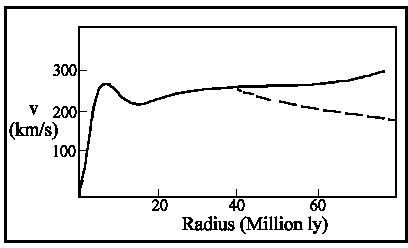What is Dark Matter Made of and Who First Discovered Dark Matter?
Who Discovered it?
It was 1932,Dutch astronomer Oort proposed the theory that this extra matter existed outside our solar system. A year later, Swiss astrophysicist Fritz Zwicky, of the California Institute of Technology found evidence of hidden mass in clusters of galaxies which was known as the “missing mass problem”. After 40 years, Vera Rubin and her co-worker Kent Ford at the Kit Peak National Observatory , measured the rotational rates of a number of distant galaxies.They did so by measuring the doppler shifts of bright clusters of stars located within each galaxy at various distances from galactic center.The result was surprising: The orbital speed of stars at the outer visible edge of the galaxy is about the same as the stars close to the galactic center.
The curve in the figure shows the radial velocity of stars versus distance from the center of the galaxy. You can see that the speed of all distant stars from the galactic center are almost same. But we did not expect that. We expected that the distant stars should move slower than the closer stars. For example, if we observe our solar system, we find that the orbital speed of pluto (the planet most distant from the sun) is only about one-tenth that of Mercury (the planet closest to the Sun).
The only explanation for the finding of Rubin and Ford that is consistent with Newtonian mechanics is that a typical galaxy contains much more matter than what we can actually see. In fact, the visible portion of a galaxy represents only about 5 to 10% of total mass of the galaxy.
So observations of Oort, Zwicky, Rubin and others lead to the conclusion that the universe abounds in matter that we cannot see. We call these “Dark Matter”.
Theories of Dark Matter and What its Made of
Currently we have two main theories to describe the nature of dark matter. One is hot dark matter and another one is cold dark matter.
According to the hot dark matter model the particles have speeds close to light and the speed of these partilces is crucial to the Big Bang model of cosmology and the formation of our universe.The best candidate to constitute the hot dark matter is the neutrino. Neutrinos have a very small mass, do not interact via either the electromagnetic or the strong nuclear force and are therefore very difficult to detect.
On the other hand, according to the theory of cold dark matter, the particles that constitute the cold dark matter are more massive than that of hot dark matter and thus slower.The candidates for cold dark matter are WIMP’s (weakly interacting massive particles - heavy neutrino, neutralino, axion) and MACHO’s (massive compact halo objects - black holes, white dwarf, brown dwarf etc.).
It is strange that the theories start from two ends. If the universe is primarily made of hot dark matter then the largest structures are formed initially and the divided to smaller structures. For example, at first super clusters of galaxies formed, then they divided into galaxy clusters, then into galaxies and then into smaller structures. But if cold dark matter is the primary component of the universe then the smaller structures gathered to form larger structures, totally opposite to hot dark matter.
But which theory is the correct one ? Cold or hot ? or Hot+cold ? The data we have received from investigation of the cosmic microwave background radiation by COBE satellite is very smooth and fast moving particles cannot clump together on this small scale from such a smooth initial clumping. Actually we need cold dark matter to get a better theory of dark matter and nowadays hot dark matter is jused a part of mixed dark matter theory.
Detecting Invisible Matter
You may ask how do we detect dark matter? We can not see them and they are really not social. They do not interact with the visible matter of our universe. But you can remember they attract! Yes, i am talking about their gravitational effect. We can observe and feel the existence of dark matter by their gravitational effect on light. Light from a very distant, bright source is bent around a massive object which is known as gravitational lensing. So gravitational lensing is a great tool for the observation of dark matter.
To prove the theories of dark matter we need to detect the particles predicted by them. Experiments are being conducted to detect dark matter. Some of them are XENON, CRESST and many new technologies are under development, such as the ArDM experiment. Recently**,** the Large Hadron Collider (It’s a particle accelerator where protons will collide from opposite sides at almost the speed of light) at CERN has been switched on. It may also find some evidence of Dark Matter.
Image Credits
Rotational Curve : Creation Research
